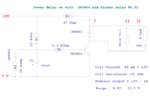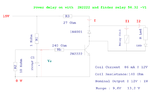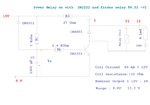jmx66
Member level 5
Hi all,
I d'be glad to get advice on this schematic , about driving a finder relay with a NPN 2N3904.
R1 and C1 are only for a delayed power on.
It'a a plug-in module, in case of failure, remove clip and put an other one, no need to desolder like a SSR.....
As usual, queries, if someone could reply, would be really great.
Are values for these resistors correct:
R3 Collector resistor
Rb Base resistor
Rl Led Resistor
I thought to add test points , but finally a green Led will do the job.
- 2N3904 Ic Maxi is about 200mA : Right use for this project, is it a power transistor or must be changed?
-About Led : Iled choice: 10mA for Vf:2,1 V
-I = 90 mA for the coil + 10 mA for the led = 100 mA
-Ic=100 mA with hfe=30 ( mini ) Vcesat=0,3V Ib=3,3mA
-Rc value (15-12-0,3)/ 100 mA= 27 Ohm Rc=27 Ohm
-Rb value for Vbe sat= 0,7 V Rb=( 15-0,7) 3,3mA Rb=4,3KOhm
-R led (12-2,1) / 10 mA R led=1MOhm
Are these basic math correct?
I made a mistake on the schematic, it is not Nominal Output , but must read Power Coil!!!!!!
Thanks a lot.
jm
I d'be glad to get advice on this schematic , about driving a finder relay with a NPN 2N3904.
R1 and C1 are only for a delayed power on.
It'a a plug-in module, in case of failure, remove clip and put an other one, no need to desolder like a SSR.....
As usual, queries, if someone could reply, would be really great.
Are values for these resistors correct:
R3 Collector resistor
Rb Base resistor
Rl Led Resistor
I thought to add test points , but finally a green Led will do the job.
- 2N3904 Ic Maxi is about 200mA : Right use for this project, is it a power transistor or must be changed?
-About Led : Iled choice: 10mA for Vf:2,1 V
-I = 90 mA for the coil + 10 mA for the led = 100 mA
-Ic=100 mA with hfe=30 ( mini ) Vcesat=0,3V Ib=3,3mA
-Rc value (15-12-0,3)/ 100 mA= 27 Ohm Rc=27 Ohm
-Rb value for Vbe sat= 0,7 V Rb=( 15-0,7) 3,3mA Rb=4,3KOhm
-R led (12-2,1) / 10 mA R led=1MOhm
Are these basic math correct?
I made a mistake on the schematic, it is not Nominal Output , but must read Power Coil!!!!!!
Thanks a lot.
jm




